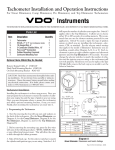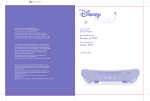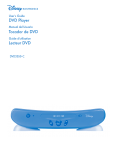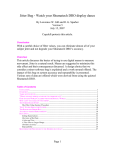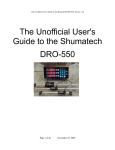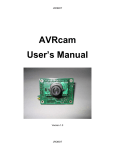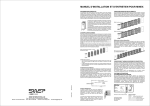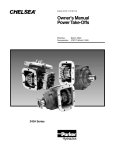Download SHUMATECH DRO-350 User's Guide
Transcript
DRO-350 User’s Guide (rev. 4) SHUMATECH DRO-350 User’s Guide 1 DRO-350 User’s Guide (rev. 4) Revision History Revision Description 1 Original version for software release 1 2 Updated for software release 2 3 Updated for software release 3 4 Updated for software release 4 Table of Contents Introduction................................................................................................................................. 2 Indicators..................................................................................................................................... 4 Keypad ........................................................................................................................................ 6 Operation..................................................................................................................................... 8 Functions................................................................................................................................... 11 Setup ......................................................................................................................................... 18 Installation................................................................................................................................. 21 Software Upgrade ..................................................................................................................... 21 Auxiliary Devices ..................................................................................................................... 26 Introduction The DRO-350 is a three-axis digital read-out (DRO) for import Chinese scales and most quadrature encoders that is designed to be as capable as commercial DROs but be a low cost alternative for the metal-working hobbyist. One of the more exciting aspects of the DRO350 is that the firmware is easily upgradeable over a serial port. This allows for continued development of the software and should allow the DRO-350 project to grow over time. Software is available for both Windows and Linux and you need only a 9 pin serial cable to connect the DRO-350. More information on the firmware upgrade capability can be found later in this document. The following list highlights the features designed into the DRO-350. Features • • • • • • • • Software upgradeable over RS-232 serial port with free Windows software Fast scale reading with a display update rate of up to 50 times a second per axis Powers scales for battery-free operation Triple data sampling for glitch free readings Three axis display with super high efficiency LEDS for maximum brightness Display brightness configurable in 20% increments Max display range of ±99.9995 inches (±999.99 mm) Incremental and absolute coordinate systems 2 DRO-350 User’s Guide (rev. 4) • • • • • • • • • • • • • • Enter zero values for both coordinate systems entered via keypad Enter incremental presets via keypad Separate zero and preset buttons for each axis Data averaging when the scale is at rest to prevent display jitter Auxiliary input for either an electronic edge finder or tachometer Third axis configurable to display tachometer in RPM or SFM Reversible axis directions Configurable auto power-off time (none, 15 min, 30 min, 60 min) Configurable tool offsets entered via keypad Setup through display and keypad Setup is retained even if power is removed Absolute zeroes and inch/metric setting are retained even after a power loss Configurable CPI for use with quadrature encoders (10-25000 CPI) Polarity axis setting to alter the location of the origin Mill-Only Features • • • Centerline function for any axis Bolt hole patterns with programmable start and end angles Cutting edge compensation based on tool offsets Lathe-Only Features • • Diameter mode (2X) for any axis with a LED indicator displayed in each axis Compound vectoring into cross-slide and carriage with configurable angle DRO-350 Front Panel There are two versions of the DRO-350, the DRO-350M for mills and the DRO-350L for lathes. The difference in the front panels is that the Y and Z axes on the DRO-350M are replaced with the Z1 and Z2 axes on the DRO-350L. The front panel is dominated by the three large LED displays which show the position of each axis as well as other information. Above the displays are five LED indicators that show current state and status. The right half of the DRO-350 contains the keypad. The keypad is used to set presets, set zeros, change modes, begin functions, enter values, etc. The following two figures show the front panel for each version of the DRO-350. 3 DRO-350 User’s Guide (rev. 4) DRO-350M Front Panel DRO-350L Front Panel Note that the software images for the DRO-350M and DRO-350L are also different. The previous release included a universal image that was the same for both DRO-350 versions. This release introduces a separate image for each. Differences in operation between these two images are noted in this document via DRO-350M and DRO-350L labels. Indicators INCR Incremental Mode This indicator is on when the DRO-350 is in incremental mode. All three axes will display their positions relative to their incremental zeros. When the indicator is off, the DRO-350 is in absolute mode and each axis will display its position relative to its 4 DRO-350 User’s Guide (rev. 4) absolute zero. Incremental zeroes are NOT retained if the power is removed. The MM key toggles between incremental and absolute modes. Metric Mode This indicator shows when the DRO-350 is in metric mode. When in metric mode, all positions either displayed by the DRO-350 or entered via the keypad are in millimeters. When the indicator is off, the DRO-350 is in imperial mode and all positions are in inches. Imperial/metric mode is retained even if the power is removed. The key toggles between metric and imperial modes. ZERO Absolute Zero Set The absolute zero set indicator is on when the DRO-350 in the middle of setting an absolute zero. The key or the axis set key must be pressed to complete the absolute zero set. Alternatively, the electronic edge finder can be used to trigger the absolute zero set at the position where an edge is contacted. Absolute zeroes are retained even if the power is removed. SET Set Value The set value indicator is a prompt that the DRO-350 expects the user to enter a number on the numeric keypad. A zero is displayed on the axis that the set is applied to. FUNC Function 5 DRO-350 User’s Guide (rev. 4) The function indicator turns on when the key is pressed to indicate that a number on the numeric keypad should be pressed to access a special function. The indicator is kept on for the time the special function is active. When it turns off, the DRO-350 is back in its normal mode. Keypad X Preset This key begins a preset operation on the X axis. See the operation section for more detail on how to set a preset. Y/Z1 Preset This key begins a preset operation on the Y axis for a DRO-350M or the Z1 axis for a DRO-350L. See the operation section for more detail on how to set a preset. Z/Z2 Preset This key begins a preset operation on the Z axis for a DRO-350M or the Z2 axis for a DRO-350L. See the operation section for more detail on how to set a preset. Zero Axis This key is used to set either an incremental or absolute zero on an axis. For detailed information on setting axis zeros, see the operation section. Absolute zeros are retained even if the power is removed but incremental zeros are not. 6 DRO-350 User’s Guide (rev. 4) Numeric Keypad Numbers are entered into the DRO-350 via the numeric keypad. It is used during preset and zero operations to enter offsets and is also used to enter information for function operations. The set indicator is lit when the DRO-350 expects the user to enter a number on the numeric keypad. key is used to finish number entry. The The key is used to delete the right-most digit or decimal point. If the number displayed is a single zero, it will end number entry without entering the number. Decimal Point This key enters a decimal point at the current position when entering a number on the numeric keypad. The position. key can be used to delete the decimal point if it is at the right-most Sign The sign key toggles between a positive or negative value while entering a number on the numeric keypad. It can be pressed at any time during number entry. Clear The clear key serves a variety of uses: • On initial power on, it clears the "dro350 r<version>" boot screen. • During number entry, it deletes the right-most digit or decimal point. If the number is a single zero, it will end number entry without entering a number. 7 DRO-350 User’s Guide (rev. 4) • During setup, it serves as a back key while paging through the setup screens. • During functions, it serves as a back key while moving through function steps. Enter The enter key serves a variety of uses: • During number entry, it is used to finish entering the number. • During setup, it serves as the forward key while paging through the setup screens. • During functions, it serves as the forward key while moving through function steps. Absolute/Incremental Toggle This key toggles between absolute and incremental positions for all axes. Imperial/Metric Toggle This key toggles between imperial (inches) and metric (millimeters) modes for all axes. Imperial/metric mode is retained even if the power is removed. Function Key The function key is pressed before one of the numbers on the numeric keypad to begin a special function. Operation 8 DRO-350 User’s Guide (rev. 4) Power On When the DRO-350 is first powered on, it will display a "dro350 r<version>" message on the display where <version> is the number of the software version. The DRO-350M version will also display a "mill" message while the DRO-350L will display a "lathe" message. The message key. This is to prevent accidental use of different can only be removed with the incremental zeros since they are lost after power is removed. The DRO-350 has an automatic power off feature that can be set to activate after a configurable period of inactivity. The inactivity time is programmed during setup. Alternatively, the keys can be pressed to immediately power off. It is recommended to leave the DRO-350 plugged in and use the automatic power off so that the absolute and incremental zeros are saved. A negligible amount of current is consumed when the DRO-350 is powered off. Fast Mode The DRO-350 programs Chinese scales into fast mode where they will update their readings at up to 50 times a second instead of the usual 3 to 5 times a second. Fifteen seconds after power on, the DRO-350 will perform the fast mode programming. You will know when this occurs because the display will briefly flash. If any scales are already in fast mode, the DRO-350 will detect this and skip fast mode programming for those scales. The fifteen second delay is necessary because some scales do not respond to fast mode programming for several seconds after they are powered on. Scale Readings The DRO-350 uses counts for all internal calculations and processing. The Chinese scales have a resolution of 20,480 counts per inch (CPI). Quadrature encoders can be configured for any CPI between 1 and 25,000. The counts are converted to inches or millimeters just prior to display. Also, if values are entered via the keypad, they are converted and stored in counts. This is done to provide maximum accuracy and minimize rounding errors during complex calculations such as with bolt-hole circles. No rounding is done on the scale readings displayed on the DRO-350 to minimize errors. The displayed readings are truncated to the display resolution. Absolute Zero Start an absolute zero set on an axis by pressing the key for that axis when the DRO-350 is in absolute mode. The zero set indicator will turn on indicating that an absolute zero set is in progress. After an absolute zero set is started, there are three ways to set the absolute zero, at the 9 DRO-350 User’s Guide (rev. 4) current position, by an offset from the previous absolute zero, or at the position of an electronic edge finder. • Set an absolute zero at the current position by pressing either the key at the desired position. • Set an absolute zero by an offset from the previous absolute zero by pressing the first number of the offset on the numeric keypad. The DRO-350 will switch to set mode and key or the you can continue entering the offset via the numeric keypad. Use the complete the offset and the • key to key to make corrections or cancel the absolute zero set. Set an absolute zero with an electronic edge finder by contacting the work piece with the electronic edge finder. An absolute zero is set at the current position on the instant of contact. Before using the electronic edge finder, make sure it is properly connected to the DRO-350 and that the auxiliary setting in the setup is set to "yes". More details on the electronic edge finder operation are in the auxiliary devices section. Incremental Zero Set an incremental zero at the current position by pressing the key when the DRO-350 is in incremental mode. The incremental zero is set immediately without any additional key presses. Absolute Preset An absolute preset is an incremental zero set at an absolute position. With the DRO-350 in absolute mode, press the preset key for the desired axis. The DRO-350 will switch to set mode and you can enter an absolute position via the numeric keypad. Use the the position and the key to complete key to make corrections or cancel the absolute preset. Incremental Preset An incremental preset is an incremental zero set at an offset from the current position. With the DRO-350 in incremental mode, press the preset key for the desired axis. The DRO-350 will 10 DRO-350 User’s Guide (rev. 4) switch to set mode and you can enter an offset via the numeric keypad. Use the complete the offset and the key to key to make corrections or cancel the incremental preset. Functions Functions are started by first pressing and releasing the key. The FUNC indicator will turn on indicating that a number key through should be pressed for the desired function. The FUNC indicator will remain on for the course of the function. Differences in the functions between the mill and lathe images are noted below via DRO-350M and DRO-350L labels, respectively. Setup This function enters the DRO-350 setup. Detailed information on setup is in the setup section. Centerline DRO350M Centerlines are meant to quickly find center points in lines and circles. The centerline function sets a zero at the half way point between the current zero and current position for an axis. If the scale is in incremental mode, the zero will be an incremental zero. Vice versa, if in absolute mode, the zero will be an absolute zero. Set a centerline zero by first moving to the desired position. Switch to incremental or absolute mode with the key for the desired zero type. Press the keys and the DRO-350 will display a prompt to press the preset key for the axis the zero is desired on. Diameter Mode Diameter mode allows work in diameter dimensions instead of radius dimensions. When an axis is in diameter mode, the axis reading is doubled and any zero or preset 11 DRO-350 User’s Guide (rev. 4) positions entered via the keypad are taken as diameter dimensions. DRO350L After pressing the keys, the DRO-350 displays a prompt to hit the preset key for the axis that diameter mode is desired on. The left-most decimal point in the display is turned on for that axis to indicate that the axis is currently in diameter mode. Selecting an axis already in diameter mode will turn it off. Diameter mode is retained even if the power is removed. Bolt-Hole Pattern Define DRO350M This function defines a new bolt-hole pattern for use with a mill. The bolt-hole pattern is stored in non-volatile memory on the DRO-350 and is retained even if power is removed. Define a bolt-hole pattern by pressing the keys. The first screen will prompt you to enter the number of holes from 1 to 99 via the numeric keypad. When entering numbers while defining the bolt-hole pattern, press the key to complete the number or the to make corrections or exit. After entering the number of holes, the next prompt will be for the radius of the bolthole circle. Next, the starting and ending angles of the bolt-hole circle are entered. The angles are entered in degrees and with respect to the following diagram when looking at the bolt-hole circle from the top: The valid angle ranges are from 0.0 to 359.9 degrees. If the same angle is entered for both the starting and ending angles, a full circle bolt-hole pattern is created. After entering the end angle, the bolt-hole pattern is stored in the DRO-350. 12 DRO-350 User’s Guide (rev. 4) Compound Angle Define DRO350L This function sets the angle of the compound for use when vectoring the compound (Z2 axis) movement into the cross-slide (X axis) and carriage (Z1 axis). The compound angle is stored in non-volatile memory on the DRO-350 and is retained even if power is removed. Positive angles indicate that the compound is positioned clockwise from the center position and negative angles indicate that the compound is positioned counter-clockwise. Enter the angle from positive to negative 99.9 degrees with the numeric keypad and press the key to accept the angle. Press the without setting the angle. to make corrections or exit Bolt-Hole Pattern Use DRO350M This function uses the defined bolt-hole pattern to set X and Y axis incremental zeros at each bolt-hole position in the pattern. The center of the bolt-hole pattern is always taken as the incremental zero of the X and Y axes when the function is started so before starting this function, set X and Y incremental zeros at the center of the bolthole pattern. Press the keys and a "hole 1" prompt is displayed. This indicates that an incremental zero is about to be set for the first bolt-hole. Press the key and the DRO-350 switches to displaying the axis positions so that you can move the X and Y axes to zero for the first bolt-hole. Press the key again and continue through the bolt-hole pattern. After the incremental zero is set for the last 13 DRO-350 User’s Guide (rev. 4) bolt-hole, press to exit out of the bolt-hole pattern use function. The incremental zeros for the X and Y axis are restored to the values that were defined for the center of the bolt-hole pattern. If you make a mistake, you can go backward through the screens at any time with the key. Compound Vectoring DRO350L This function toggles compound vectoring on and off. Compound vectoring takes the movement of the compound (Z2 axis) and vectors (or sums) it into the cross-slide (X axis) and carriage (Z1 axis) according to the current angle set for the compound. For example, if the compound angle is set to 30 degrees and the compound is moved 1.000, then vectoring would add 1.000 * sin(30) = 0.5 to the cross-slide and 1.000 * cos(30) = 0.866 to the carriage. Compound vectoring mode is retained even if the power is removed. Tool Offset Define DRO350M This function defines one of 9 tool offsets for cutting edge compensation. The tool offsets are stored in non-volatile memory on the DRO-350 and are retained even if power is removed. The tool offsets are defined in terms of the tool diameter and the Z axis offset. Define a tool offset by pressing the keys. The first screen will prompt you to enter the tool offset number 1-9 with the numeric keypad. After pressing the number, you will be prompted to enter the tool diameter. When entering the offsets, key to complete the offset or the to make corrections or exit. press the Next, you will be prompted to enter the Z offset. After entering the Z offset, the tool offset is stored in the DRO-350. Tool Offset Define This function defines one of 9 tool offsets for lathe operations. The tool offsets are stored in non-volatile memory on the DRO-350 and are retained even if power is 14 DRO-350 User’s Guide (rev. 4) DRO350L removed. The tool offsets are defined as offsets of the X and Z1 axes. The following figure shows a visual representation. Define a tool offset by pressing the keys. The first screen will prompt you to enter the tool offset number 1-9 with the numeric keypad. After pressing the number, you will be prompted to enter the X offset. When entering the offsets, press the key to complete the offset or the to make corrections or exit. Next, you will be prompted to enter the Z1 offset. After entering the Z1 offset, the tool offset is stored in the DRO-350. Tool Offset Use This function selects one of the defined tool offsets. Use a tool offset by pressing the DRO350M keys. The DRO-350 prompts you to select a tool offset number 0-9 with the numeric keypad. Tool offsets 1-9 are defined by the user whereas tool offset 0 is implicitly a tool with no offsets and is effectively used to turn off tool offsets. After selecting the tool offset, use the numeric keypad to select the cutting edge to compensate for. The edge positions are selected according to the following keypad pattern. 15 DRO-350 User’s Guide (rev. 4) When an axis position is compensated due to an edge position selection, the left-most decimal point in the display for that axis is turned on. The tool offset in use is retained even if the power is removed though the cutting edge is not. Tool Offset Use This function selects one of the defined tool offsets. Use a tool offset by pressing the DRO350L keys. The DRO-350 prompts you to select a tool offset number 0-9 with the numeric keypad. Tool offsets 1-9 are defined by the user whereas tool offset 0 is implicitly a tool with no offsets and is effectively used to turn off tool offsets. The tool offset in use is retained even if the power is removed. Tachometer The tachometer function is only available if the auxiliary setting in the setup is set to yes. Selecting this function will toggle between the Z/Z2 axis position and the tachometer reading in RPM. Details on the tachometer operation are in the auxiliary devices section. Tachomter mode is retained even if the power is removed. Surface Feet Per Minute DRO350M The surface feet per minute (SFM) function is only available if the auxiliary setting in the setup is set to "on". This function takes the RPM reading from the tachometer and the currently selected tool diameter and calculates the SFM with the equation SFM = (RPM * 2 * PI * radius) / 12. The result is displayed on the Z axis. Selecting this function will toggle between the Z axis position and the SFM reading. Details on the tachometer operation are in the auxiliary devices section. SFM mode is retained even if the power is removed. Surface Feet Per Minute DRO- The surface feet per minute (SFM) function is only available if the auxiliary setting in the setup is set to "on". This function takes the RPM reading from the tachometer and the absolute position of the X axis as the radius and calculates the SFM with the 16 DRO-350 User’s Guide (rev. 4) 350L equation SFM = (RPM * 2 * PI * radius) / 12. The result is displayed on the Z2 axis. Selecting this function will toggle between the Z2 axis position and the SFM reading. Details on the tachometer operation are in the auxiliary devices section. SFM mode is retained even if the power is removed. Power Off This function is used to immediately power off the DRO-350. When powered off, all display elements are turned off and only a small amount of current is used. The scales are kept powered on so that the zeros are not lost. Fast Mode Toggle Pressing the key followed by one of the axis preset buttons will program the fast mode sequence on the Chinese scale connected to that axis. This function can be used to put a newly connected scale into fast mode without powering the DRO-350 off and back on. Counts Display This function is used to display the raw counts in hexadecimal format for each axis instead of the corresponding reading in inches or millimeters. This function is used for troubleshooting and helping to determine the threshold for the averaging filter. Entering this function keypress again will change the display back to a reading in inches or millimeters. 17 DRO-350 User’s Guide (rev. 4) Setup Setup is entered by pressing the keys. The setup screens are show in order below. key to move forward and the key to move Setup is navigated by pressing the backward. The setup is saved to non-volatile memory when you move forward from the last screen. You can make changes to setup without saving them to non-volatile memory by going backward through the screens until you exit setup without moving forward on the last screen. The possible options for each setting are cycled through by pressing the preset key for the axis you want to change. If a setting is not axis-specific, then press any preset key to cycle through the options. Direction This setting controls the direction of travel of the scale for each axis. Pressing the preset button for an axis will toggle between "fo" (forward) and "re" (reverse) for that axis. Adjust this as necessary to get the correct direction of travel depending on how your scales are installed. Polarity This setting controls the polarity of each axis for use in changing the origin position. This setting affects all of the functions that operate on absolute directions such as tool offsets, bolt hole circles, etc. By default, this setting is "po" for positive which corresponds to default origin positions as follows: DRO-350M: • • • X - positive towards the right Y - positive towards the rear Z - positive up DRO-350L • X - positive towards the front 18 DRO-350 User’s Guide (rev. 4) • • Z1 - positive towards the right Z2 - positive towards the right To change the origin to the opposite position, change this setting to "ne" for negative. For example, if the Y axis is changed to "ne", then it will be positive towards the front instead of the rear. Counts Per Inch The counts per inch (CPI) setting is for quadrature encoder use. The valid CPI range is from 10 to 25000 and must be a multiple of 10. For Chinese scales, a CPI setting of 20480 should be used. To set the CPI for an axis, press the preset button for that axis and enter the setting on the numeric keypad. Press the press the key to confirm the setting or key to erase digits or to cancel entry. When using the QCC-100, the value here must be four times the resolution of the disk or strip used by the quadrature encoder. The reason for this is that the QCC-100 quadruples the resolution and this must compensated for here. For example, a 500 CPI strip would be entered as 2000 CPI here. Filter Threshold This setting controls the threshold in counts for the digital averaging filter for each scale. This filter attempts to keep the axis reading from bouncing or jittering when the scale is not moved so a steady reading is displayed. When the scale is moved more than the threshold, the filter immediately displays unfiltered readings until the scale is stopped again. After the scale is stopped, the filter will again average readings together to arrive at a steady reading. Press the preset key for an axis to enable threshold entry. Use the numeric keypad to enter the threshold in counts and press the key. The key is used to erase digits or to cancel the threshold 19 DRO-350 User’s Guide (rev. 4) entry altogether. This threshold setting is a tradeoff between stability and being able to detect small amounts of travel. Increase this setting if the scale reading bounces too much and set it lower if you want more sensitivity to small movements. Oversample This setting controls the triple oversampling built into the DRO-350 that helps reduce the effects of noise on the scale signal lines. A small minority of Chinese scales have a serial stream with an output frequency that is much faster than most and it may be too fast for the processor inside the DRO-350 to handle while performing triple oversampling. By setting this to "n", the DRO-350 can support these scales with the drawback of reduced noise immunity. Setting this to "y" turns on triple oversampling and is the recommended and default setting for most scales. Intensity This setting controls the intensity of the indicator and display LEDs. Pressing any preset key will toggle between the following values: • • • • • 5 - 100% intensity 4 - 80% intensity 3 - 60% intensity 2 - 40% intensity 1 - 20% intensity Auxiliary Device The auxiliary device in use on the DRO-350 is selected by this setting. Pressing a preset key will toggle between "tach" for tachometer and "edge" for electronic edge finder. If no auxiliary device is in use, leave the setting on its default value of "tach". Auto-Off 20 DRO-350 User’s Guide (rev. 4) The inactivity time before automatically powering off is controlled by this setting. If there is no interaction with the DRO-350 keypad for this amount of time, then it will automatically power off. Pressing any key will power the DRO-350 back up. The possible values selected with the preset key are 60, 30, and 15 minutes. Installation Installation of the DRO-350 and the Chinese scales is highly dependent on the machine it is being installed on. Check the ShumaTech message board to see if you can find specific recommendations for your machine. One important installation recommendation has to do with the Chinese scales. These scales have a metal back that is connected to the positive side of the battery. When mounted on the machine, the scales are electrically coupled together through the machine. The DRO-350 powers the scales by providing 1.5V DC over the scale cables so that the batteries are not necessary. If the batteries are removed, some scales my bounce around more than when the batteries were installed. This is due to lack of filtering of the power supplied by the DRO-350 at the scale. If you experience this problem, it can be overcome one of two ways. The first way is to solder a 100uF capacitor across the battery leads on the scale. This will provide the necessary filtering of the power supply and the scales will be just as quiet as when the battery is installed. You won't need to worry about batteries ever again since the DRO-350 will supply all of the power needed by the scale. Look at the modifications page for detailed instructions on how to install the capacitor on the scale. If you don't want to solder a capacitor to your scales, the other alternative is just to leave the batteries in the scales. The DRO-350 will still supply power to the scales so the batteries will drain much slower than normal. Batteries essentially look like a large capacitor to a circuit so this will supply the necessary filtering of the power supply as well. Software Upgrade The DRO-350 has a built-in programmer for its PIC microcontroller. This allows the software to be easily upgraded over a serial port. There are two programs recommended for use with the DRO-350, IC-Prog and PonyProg. Detailed instructions for each program is given below. Before starting the software, you must connect the DRO-350 to your computer. Do so by connecting the DRO-350 with a standard DB-9 serial cable to a free serial port. IMPORTANT: Disconnect the power supply, auxiliary device, and scales from the DRO-350. The serial port provides all necessary power while programming the DRO-350. IC-Prog 21 DRO-350 User’s Guide (rev. 4) Download IC-Prog from the web site and follow the installation instructions. Start the program and select the Settings -> Hardware from the menu. You will be presented with the following dialog box: Select "JDM Programmer" from the drop down list under "Programmer:". Select the serial port that you connected the DRO-350 to in the "Ports" section. The "Interface" setting will normally be correctly set so do not change it unless IC-Prog gives you a serial communications error. Leave the "I/O Delay" and "Communication" settings alone. Click "OK" to save the settings. Next, do a preliminary check of the serial interface by selecting Settings -> Hardware Check from the menu. The following dialog box will come up: Turn on "Enable MCLR" by selecting the check box. The programming LED on back of the DRO-350 should come on. If it does not, check your serial connection and also make sure that you unplugged all other cables from the DRO-350. Unselect the check box and clock "OK" to continue. The next step is to select the correct PIC microcontroller from the device list. The DRO-350 uses the PIC16F876A microcontroller so select it from the device list. This is shown in the following window: 22 DRO-350 User’s Guide (rev. 4) Now you are ready to open the DRO-350 software image. Download the desired software image from this web site and extract the HEX file. The file name will be in the format dro350r<ver>.hex where <ver> is the software version. Select File -> Open from the menu and open the HEX file. Once you do this, you should see a window similar to the following: 23 DRO-350 User’s Guide (rev. 4) The program code window should now show hexadecimal numbers other than just 3FFF and the configuration on the right should be set as shown above. The oscillator, write enable, fuses, and checksum are set correctly from the HEX file so do not change them after opening the HEX file. Note that the checksum will be different in every software version and will not be the same as what is shown above. You are now ready to start programming the DRO-350. Select Command -> Program All from the menu. IC-Prog will ask for confirmation for the operation. Select "Yes" and you will be presented with the following dialog box: If IC-Prog shows a serial communications error message, first double check that you are using the correct serial port. If so, then go to Settings -> Hardware and try changing the "Interface" setting. After programming completes, the code is verified and you will see the following dialog box: 24 DRO-350 User’s Guide (rev. 4) IC-Prog will show the following dialog box if the verification is successful. If the verification fails, don't worry, no permanent damage is done. There are two common verification failures - data and code. A data verification failure can be safely ignored and just means that the EEPROM was not fully zeroed. The message displayed will say "Verify failed at data address XXXXh". Note the word "data" in front of "address". If the message says "Verify failed at address XXXXh", note that the word "data" is not in front of "address", then the code verify failed and there is some sort of problem. Here is a list of common problems to check for: • • • • • Unconnected or incorrectly wired signals between the DB-9 connector and JP1 Using a null modem cable instead of the required straight-through cable Diode D2 is soldered in the via inside of the white outline instead of the hole on the outside One of the diodes D2-D7 has the wrong orientation The I/O delay setting in IC-Prog (Hardware -> Settings) is either too fast or too slow for the computer. Try a few slower and faster values. 25 DRO-350 User’s Guide (rev. 4) • The computer's serial port is not generating enough voltage swing. The programming LED not coming on is one sign of this. Try programming on another computer. Newer computers and laptops are more likely to have this problem. Auxiliary Devices Tachometer The tachometer function of the DRO-350 is used to display the spindle speed of a mill or lathe. A small probe that optically measures the rotational speed is mounted to the machine. The probe sends a 5V pulse to the DRO-350 through the auxiliary connector for every rotation of the spindle. The DRO-350 measures the period between these pulses and converts it to either RPM or SFM for display on the Z/Z2 axis. The tachometer display is updated once per second. Electronic Edge Finder Absolute zeros can be set on the DRO-350 with an electronic edge finder by contacting the work piece with the edge finder while it is mounted in the spindle. Many commercially available edge finders can be adapted for use with the DRO-350. A circuit inside the edge finder sends a 5V pulse to the DRO-350 through the auxiliary connector. To set the absolute zero for an axis with the electronic edge finder, set the DRO-350 to absolute mode and press the button once for that axis. When the edge finder contacts the work piece, the axis is zeroed at the current position. To compensate for the diameter of the edge finder, use a tool offset with the cutting edge compensation feature. 26


























